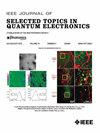Scaling Characteristics of Multijunction VCSELs
IF 4.3
2区 工程技术
Q1 ENGINEERING, ELECTRICAL & ELECTRONIC
IEEE Journal of Selected Topics in Quantum Electronics
Pub Date : 2024-09-24
DOI:10.1109/JSTQE.2024.3467036
引用次数: 0
Abstract
Increasing the number of active regions is an effective approach for scaling optical output power in Vertical-Cavity Surface-Emitting Lasers (VCSELs). LiDAR applications utilizing Time-of-Flight (ToF) mapping methods require power-efficient VCSELs with high throughput and fast rise times to achieve high spatial resolution and extended detectable ranges. This paper presents a comprehensive study on the performance characteristics of multijunction VCSELs. Single-, triple-, and five-junction 940 nm VCSELs are designed and fabricated into both single aperture dies and densely packed arrays. Electro-optical characterization results demonstrate the scaling behavior of these devices, where the differential quantum efficiency increases from 65% for the single-junction VCSEL to 360% for the five junction VCSEL, corresponding to the slope efficiencies of 0.9 W/A and 5.0 W/A. On the other hand, a broadening in spectral response and far-field beam divergence angle is observed by increasing the number of active junctions, which is primarily caused by the stimulation of additional higher order transverse modes. This study aims to analyze the effects of increasing the number of active junctions on VCSEL performance and to address the associated challenges in the development of multijunction VCSELs.求助全文
约1分钟内获得全文
求助全文
来源期刊

IEEE Journal of Selected Topics in Quantum Electronics
工程技术-工程:电子与电气
CiteScore
10.60
自引率
2.00%
发文量
212
审稿时长
3 months
期刊介绍:
Papers published in the IEEE Journal of Selected Topics in Quantum Electronics fall within the broad field of science and technology of quantum electronics of a device, subsystem, or system-oriented nature. Each issue is devoted to a specific topic within this broad spectrum. Announcements of the topical areas planned for future issues, along with deadlines for receipt of manuscripts, are published in this Journal and in the IEEE Journal of Quantum Electronics. Generally, the scope of manuscripts appropriate to this Journal is the same as that for the IEEE Journal of Quantum Electronics. Manuscripts are published that report original theoretical and/or experimental research results that advance the scientific and technological base of quantum electronics devices, systems, or applications. The Journal is dedicated toward publishing research results that advance the state of the art or add to the understanding of the generation, amplification, modulation, detection, waveguiding, or propagation characteristics of coherent electromagnetic radiation having sub-millimeter and shorter wavelengths. In order to be suitable for publication in this Journal, the content of manuscripts concerned with subject-related research must have a potential impact on advancing the technological base of quantum electronic devices, systems, and/or applications. Potential authors of subject-related research have the responsibility of pointing out this potential impact. System-oriented manuscripts must be concerned with systems that perform a function previously unavailable or that outperform previously established systems that did not use quantum electronic components or concepts. Tutorial and review papers are by invitation only.
 求助内容:
求助内容: 应助结果提醒方式:
应助结果提醒方式:


